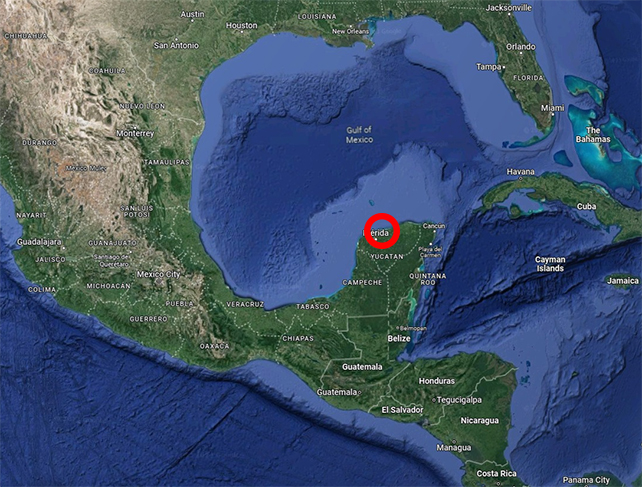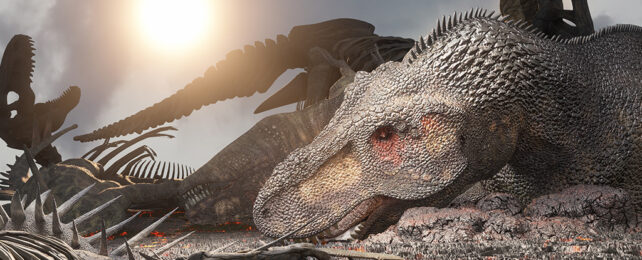Some 66 million years ago, life on planet Earth was interrupted by a catastrophic event. From what we can piece together today, an asteroid roughly 12 kilometers (7.5 miles) wide slammed into the ocean near what is now the Yucatán Peninsula in Mexico.
The consequences of this impact would ultimately cause three out of every four plant and animal species around the globe to perish, ending the dominance of that most famous group of creatures, the dinosaur.
While shooting a planet with a high-speed rock the size of a mountain is clearly going to have some kind of effect on its environment, wiping out a diverse group of animals that had thrived for 165 million years seems a little, well, dramatic.
So how exactly did the dinosaurs die? And could an asteroid affect life to the same degree in the future?
How do we know an asteroid killed the dinosaurs?
Our modern world contains a conspicuous lack of large toothed, scaly-skinned animals that stomp around the countryside going rawr, coo, and chirp. According to the fossil record, dinosaurs once filled a variety of ecological niches all around the world.
The moment in time this all changed is reflected by the contents of a distinct layer of sedimentary rock called the Cretaceous–Paleogene (K–Pg) boundary.
A site at El Kef in Tunisia is used to conveniently represent the standard for this vast sheet, though in reality the sheet of compacted dust stretches around the planet at a thickness of around 2 to 3 centimeters (about an inch).
Below this rock? Lots of dinosaurs. Above it, the closest things to dinosaurs we can find are the smaller feathered varieties we call birds.
In spite of being so thin, a few centimeters of sedimentary rock can still pack in tens of thousands of years of material. For decades paleontologists presumed the loss of dinosaur species was relatively gradual.
In the 1970s, the American geologist Walter Alvarez was busy studying the chaotic assortment of rock layers in the Italian mountains, layers which included the K-Pg boundary. To determine the actual time it had taken for the layer to form, he turned to his father, the physicist and Nobel laureate Luis Alvarez, who suggested measuring the amount of decay in the isotope beryllium-10 as a timer.
It would have been a nice idea, if not for the fact that all of the beryllium would have long since decayed, leaving nothing worthwhile to measure. So another element – iridium – was proposed as a substitute.
As is the case with many of the planet's heavier elements, much of Earth's iridium would have sunk towards its core over its history. Any found close to the surface most likely arrived with the light haze of dust that settles onto our planet each day from interplanetary space.
Alvarez and his father expected maybe one out of every ten billion particles would be iridium. What they found was a concentration thirty times greater. More shocking still, the element was found in concentrated levels within this same layer all over the planet.
This burst of iridium implied more than the typical gentle dusting of cosmic grit. Supernovas could be ruled out, since there was no trace of the isotope plutonium-244 to be found alongside the iridium spike. Which left one sudden dose of space rock.
The 1980s was an exciting time for geologists, chemists, and paleontologists keen to piece together a scenario around the asteroid impact hypothesis.
Shortly after Alvarez and his father published their hypothesis, an oil company identified traces of a 180-kilometer-wide (110 mile) crater beneath the Yucatán, though it wouldn't be until the 1990s that the 'Chicxulub' (pronounced chicks-su-loob) crater would be confirmed as the site of the impact that left the iridium found in the K-Pg boundary rock.

Today there's little debate over the fact that a large asteroid hit our planet around 66 million years ago, and the timing of this impact coincided with a monumental extinction event.
What is still a matter of discussion is precisely how a moderately sized meteorite could have caused such carnage.
How did an asteroid impact cause the extinction of so many species?
Asteroids are obviously bad news for life on Earth. If you happen to be standing close to the impact site, the blast and shockwave of an impact will quickly turn your meat sticks into a charred blob. No mystery there.
Further abroad, the pall of dust and smoke in the atmosphere would generate some serious changes in the global climate, altering temperatures and food chains in ways that would quickly see to the demise of many species.
There's plenty of evidence that Earth was rocked by the gut-punch of the K-Pg impact. Tsunami 'megaripples' point to the sheer power of the explosion. Chemical signatures of a global pall of sunlight-blocking particulates back up the likelihood of a planetary winter. There are even signs of a drastic altering of ocean chemistry that would explain the huge loss of marine life.
But are these changes, as massive as they are, enough to explain the scale of devastation? Sure it was a big chunk of rock, but life has proven to be surprisingly resilient in the face of large changes.
There's some argument that dinosaurs – especially large ones – were especially prone to large scale environmental changes, and possibly already on their way out. The asteroid impact just tipped them over the edge. It's a hypothesis that continues to draw heavy debate, with evidence proving difficult to interpret one way or another.
A pulse of eruptions from a field of volcanoes in what is today India might (or might not) have added to this no good, terrible day in dinosaur history, throwing toxic material into the atmosphere. While we can be confident geological activity was intense during this period, we're still not sure if it was enough to really impact global ecology.
One hypothesis that has gained ground in recent years proposes it was less a matter of size, and more the precise placement of an impact such as this that truly shakes up the planet's atmosphere. Even moderately sized chunks of rock from space can kick off long periods of serious cooling if they strike geology containing the right kind of mineral.
Throw in the fact the meteorite could have come in at a crucial angle, we might have good reason to imagine the same 12-kilometer-wide asteroid might have been less destructive had it hit a few seconds later, at a slightly different spot at a slightly different degree.
Which would make it less a bad day for dinosaurs, and more a matter of terrible timing of a horrible few seconds.
Could this horrible few seconds happen again?
Knowing how life is so easily threatened by the effects of a massive asteroid strike, astronomers are keeping their eyes peeled for large rocks that just might cross our orbit some time in the future.
Near-Earth Asteroid monitoring programs tasked with giving us a heads-up on potentially devastating impacts suggest there's nothing to worry about in the near future.
Barring rare instances of being blindsided by a rock hidden by the Sun's glare, or an asteroid being nudged by gravity in hard-to-predict ways, it seems we've got plenty of time to come up with a plan.
Still, given enough time we might expect Earth to experience a similar impact again. If we can't use technology to avoid being struck, we'd need to brace for some kind of ecological consequences.
If the conversation on the K-Pg extinction has taught us anything, though, it's that there are plenty of variables that could determine the extent of damage caused by an asteroid hit. A smaller impact in the wrong place could prove catastrophic, for instance, while a glancing blow in a less troublesome corner of the globe from a bigger boulder might be less cause for concern.
Either way, any ecosystem already weakened to the brink of collapse almost certainly wouldn't fare well from a sizeable asteroid strike. If we don't want to go the way of the dinosaur in the future, we could do worse than ensuring our planet has all it needs to quickly bounce back from a cosmic apocalypse.
All Explainers are determined by fact checkers to be correct and relevant at the time of publishing. Text and images may be altered, removed, or added to as an editorial decision to keep information current.
